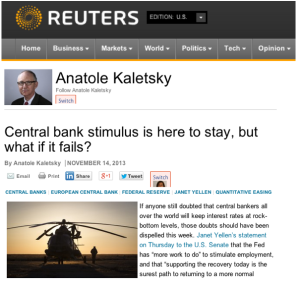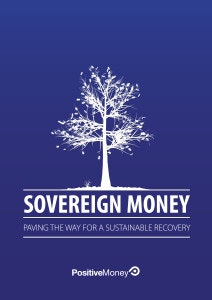What if the world economy fails to spring back to life? (Anatole Kaletsky)


Anatole Kaletsky’s latest article is well worth reading. Entitled “Central bank stimulus is here to stay, but what if it fails?”, Kaletsky discusses the scenario when the world economy fails to spring back to life, despite all the current stimulus (Quantitative Easing). One option he describes is ‘a retreat from monetary stimulus’, and leaving the markets to do their own thing. But that’s not the most likely reaction, Kaletsky argues:
“A much more likely reaction to failure of the present stimulus attempts would be bolder experiments with new measures that act directly on consumer demand. The obvious way to do this would be to combine monetary and fiscal policy into a new form of unified stimulus that would put money directly into consumers’ pockets, instead of relying on trickle-down effects from financial markets, where wealthy investors become even richer because the central bank boosts asset prices by buying government bonds.
“As this column has repeatedly argued, the Fed could have delivered vastly more powerful economic stimulus through its QE program if it had sent out a check of $270 every month directly to each of the 315 million U.S. citizens, instead of transferring the same $85 billion monthly to bond investors, as it has been doing now for over a year.
“This kind of monetary ‘helicopter drop’ was what Milton Friedman recommended for economies still facing persistent unemployment after interest rates were reduced to zero and Ben Bernanke strongly advocated “helicopter money” for Japan before he became Fed chairman.
“Even a few months of free money distributions to ordinary American households would almost certainly have done more to encourage consumer spending and economic activity than years of conventional bond purchases by the Fed. Helicopter money would therefore have revived the economy more quickly and with much less expansion of the Fed’s balance sheet than conventional QE. So helicopter money would actually have been a more cautious form of monetary stimulus than QE, with less inflationary potential.
You can read the whole article here.
One measure that would act directly on consumer demand is the Sovereign Money creation – a policy that relies on the state creating money and putting this money into the economy. Whereas Quantitative Easing relied on flooding financial markets and hoping that some of this money would ‘trickle down’ to the real economy, Sovereign Money Creation works by injecting new money and spending power directly into the real economy. Depending on how it is implemented, the policy could be many times more effective at boosting GDP than Quantitative Easing.
Will Sovereign Money creation lead to high inflation?
A common concern with Sovereign Money creation (SMC) is that cooperation between the fiscal and monetary authorities will lead to the power to create money being excessively used, resulting in high levels of inflation, or even hyperinflation.
These concerns are reasonable and point to the need for a strong governance structure around the use of SMC. The recent financial crisis demonstrated the dangers of allowing any organisation to have the power to create money without appropriate safeguards. Organisations, such as commercial banks today, which are able to create money and benefit from doing so, will naturally have an incentive to create too much money. This tends to lead to economic instability. Looking at a dataset comprising 14 advanced countries and covering the period between 1870 and 2008, Taylor (2012) finds that the most important variable in predicting financial crises is past credit growth:
“Over 140 years there has been no systematic correlation of financial crises with either prior current account deficits or prior growth in public debt levels. Private credit has always been the only useful and reliable predictive factor.”
For this reason, the state – through the central bank – attempts (often unsuccessfully) to restrict bank activities in order to prevent the harmful effects of excessive money creation: inflation, instability, and financial crisis.52 Likewise, to prevent politicians from abusing the power to create money, this power (and monetary policy in general) is devolved to an independent central bank.
To prevent the abuse of SMC, all that is required is that the decision over how much money to create is delegated to an organisation that does not have a conflict of interest. In this case, this means that the beneficiary of money creation – in the case of SMC the government – is not also able to decide the amount of money to create. This is the approach followed in Jackson and Dyson (2012) as part of a larger set of reform proposals. In a recent debate, Adair Turner also advocated similarly:
“Under the Outright [overt] Monetary Financing approach … the scale of money financed fiscal deficits would be clearly determined in advance by an independent central bank. The fiscal authority would decide how to spend the money (the balance between tax cuts and public expenditure): but the central bank would determine the amount of permanent money finance, consistent with an appropriate inflation or money GDP target. And it would do so as an independent central bank, and through the same decision making processes which govern the use of other monetary-policy tools.” (Reichlin, Turner, Woodford, 2013) [our addition in square brackets]
The simplest way to ensure that the central bank does not create too much money is for monetary policy to continue targeting inflation (on its own or as part of a broader set of targets). Higher levels of inflation would therefore automatically lead to the central bank reducing (or halting) SMC. SMC therefore gives the central bank another tool that it can use to aim at its targets, but does not open the door to unconstrained money creation by the state. The decision on whether to undertake SMC should be taken by the MPC in its monthly meetings, alongside its other monetary policy decisions.

A longer discussion of the conflicts of interest and governance issues inherent in SMC can be found in Part 2 of our new report Sovereign Money Creation: Paving the Way for a Sustainable Recovery